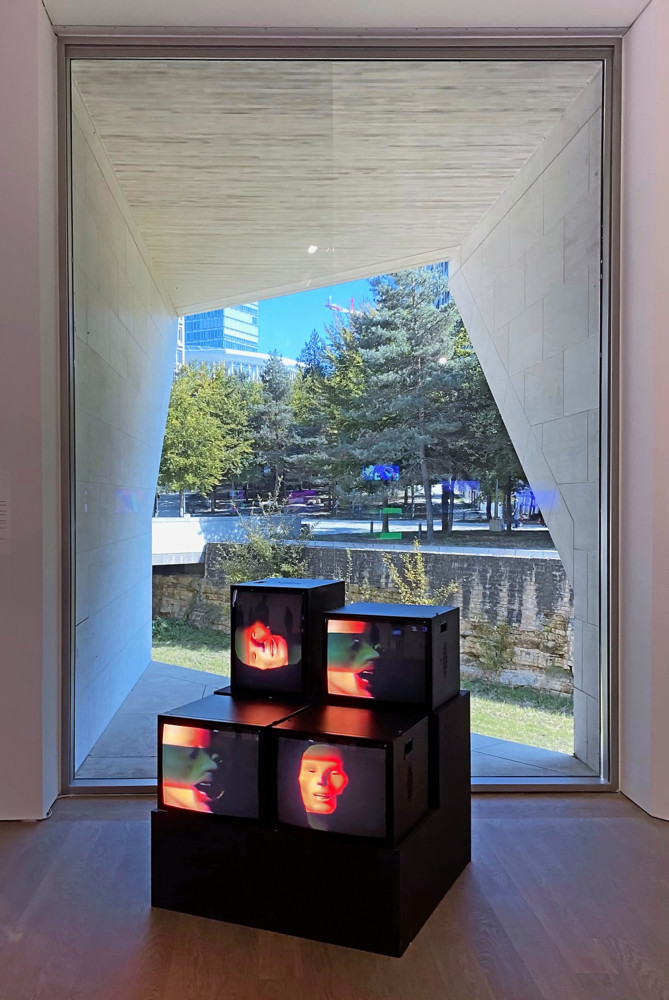Mudam highlights pioneers of computer art creation with exciting back-to-school exhibition “Radical Software.”
Under Deborah Remington's brush, the computer appears as a jumble of cool, dark, but sharply edged, red blocks, emerging from the shadows into a halo of light. When the American painter realizes Merthyr (1966), one of the first works to be seen in the exhibition “Radical Software: Women, Art and Computing 1960-1991,” the computer is still this massive machine that takes up an entire room, and which was intended for some edge uses: “military and government organizations, scientific laboratories, large corporations…,” says Michelle Cotton, the exhibition’s curator.
Since the personal computer had not yet come into being, the machine carries within it an element of mystery that intrigues, disturbs, and fascinates. Remington’s painting, she explains, “straddles the line between abstraction and figurative art,” intended to be “a fantasy of the interior of the machine,” of what it is made of. The colors, shapes, and symbolism evoke the female reproductive system, as a means of giving life to this other machine that we say is disembodied. And thus another story of “computer art” was born.
With the heavy task of first and foremost chronicling the beginnings of digital art through a female perspective, Mudam's Back to School exhibition presents more than a hundred works created in the space over the past 30 years, up to the inception of the public Internet (World Wide Web) in 1991.
The works on display are “mostly produced using computers,” but not only that. The “computer” (“calculator,” in its original sense), far from being used exclusively as a tool by these artists, also appears as a “source of inspiration” (here, Deborah Remington) whose influence can extend to the artist’s ideas. Gesture (the performative practice of writing by the German Hanne Darboven imitates the work of an automatic machine).
Zero and one
In the emerging digital art of the 1960s and 1970s, the general problem tends to be to discover the machine, and therefore to understand it. Indeed, “writing and text, through symbols, zeros and ones, occupy a large part of this exhibition,” warns Michelle Cotton. There we encounter the work of Vera Molnar, who programmed the machine in a way that imitated her mother’s handwriting.
What about Alison Knowles' weird romantic work? dust house (1967), or a poem generated randomly by a computer according to data and criteria programmed by the artist? The curator analyzes: “At a time when computing is still largely associated with the idea of order, social organization or administration,” Alison Knowles’s stand-alone verses represent a rare example of using a computer in a “playful play.” A joyful and poetic perspective.

She also points out that although many works dating back to the 1960s and 1970s were actually produced on computers, “artists were only able to discover the works after they were printed.” Naturally, “accelerating technological developments” will change this. The computer is becoming smaller, more accessible, and is beginning to invade everyday life.
When the production of electronic images becomes possible, the computer is no longer just the artist's working tool or source of inspiration: it also becomes a support for the work. But with a touch of irony, the digital paintings of the Swedish artist Charlotte Johansson, which at the time had to be printed to be displayed, are finally displayed after about 40 years “as they were made”: on screens.
Cyberwoman and Cyberfeminism
By implementing its unique perspective on the history of “computer art,” the exhibition presents and weaves together a little-known history of research and technological developments in computing, of this desire to test the machine, to support its evolution. More than just a collision of the worlds of computing and art, “Radical Software” reveals the porosity that exists between disciplines.
There we meet Inge Borchardt, a computer programmer turned artist, who showed Modam a series of computer-generated drawings in 1966; Ruth Levitt, who in 1977 programmed her own 3D modeling program to create a sculpture, which can now be found in the Adobe Photoshop base; or Tamiko Thiele, an artist and researcher who in the mid-1980s was inspired by the human brain to develop the design of the Communication Machine, the first commercial supercomputer, whose appearance gave ideas to a certain Steve Jobs.
Many female machines, though crucial in their work, have remained in the shadow of their male counterparts. swimmer (1981), American artist Rebecca Allen admits that she “always felt intrusive in these environments,” computer or animation labs. This first computer simulation of a female body in motion, designed in reaction to an earlier “very static” model (implemented by lab director Ed Catmull), still seems revolutionary today.
In 1985, philosopher Donna Haraway declared the age of “cyberfeminism.” In this exciting new timeline of technological progress, Modem Gallery plows its furrow. Some artists have not given up. Ruth Schnell critiques “the idea of male-female relations that cinema and media have served us” in her video work Plushlov (1984). At 68, the Austrian artist has long since given up her Commodore 64 computer, but her approach to computing has not changed: “Today, I integrate artificial intelligence into my artwork in the same way: for critical use.”
Until February 2, 2025.
Modam – Luxembourg.

![[Exposition] The Other Story of “Computer Art”](https://technewsinc.com/wp-content/uploads/2024/09/983086_cx__cy__cw__ch_-840x450.jpeg)



